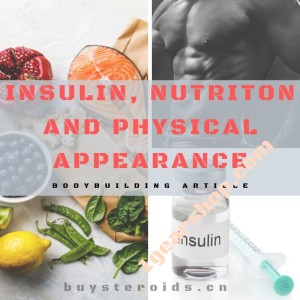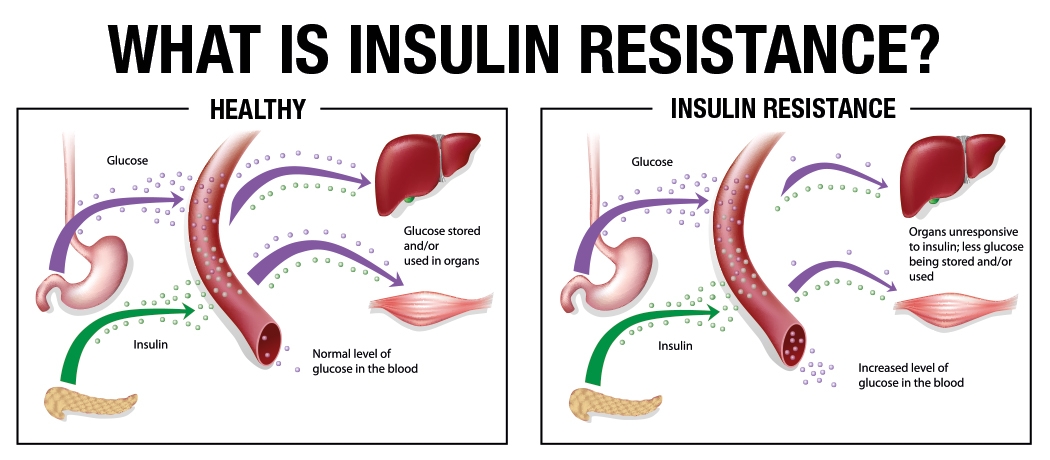Insulin, Nutrition And Your Physical Appearance

Insulin, nutrition and your physical appearance
Do you know what insulin resistance is? But what about insulin sensitivity? Both terms are often used in articles about muscle mass, weight loss and health by many nutrition experts. But do you really understand what good insulin health means?
Insulin plays a major role in body composition (the ratio of muscle mass to fat) by mediating fat burning and energy levels, being directly involved in the development of lean muscle tissue.
Insulin health is a complex process, but mastering it well is one of the most important things you can do to feel better and to have a sports physique.
In this article we will analyze the basics of insulin health. We will look at how insulin affects body composition and energy production and see what strategies we can take to improve processes.
What is insulin?
Insulin is a hormone secreted by the pancreas - an organ behind the stomach - especially after eating carbohydrates but also other foods such as whey protein.
When you eat carbohydrates and are absorbed into the bloodstream, they increase blood sugar levels (glucose), which is detected by the pancreas. The pancreas begins to secrete insulin to help the body process blood glucose.
In a healthy body, insulin binds to receptors on cells. When a cell has insulin attached to it, through specific receptors, other receptors in the cell (act as messengers) are activated to absorb glucose from the blood inside the cell to be used as energy.
What is insulin resistance?
Insulin resistance is perpetual; there is no such thing as being either insulin resistant or insulin sensitive. There are no absolute terms, and the good news is that you can change the way cells respond to insulin, being either more sensitive or more resistant.
Insulin resistance occurs when the body's cells are less receptive to insulin and the receptors do not bind so well. Insulin resistance is like having locks on the door. In a healthy body, insulin is similar to a key that unlocks a door so that glucose (from carbohydrates eaten) can pass through the blood inside the cell to be burned or stored.
If your body is very sensitive to insulin and you eat foods that manage insulin secretion, the whole process works perfectly and everything is very effective. But if the cells are insulin resistant, it fails to fully open the door for glucose to enter the cells, and the pancreas continues to secrete insulin because it detects the presence of glucose in the blood. The pancreas will think that more keys are needed to open the doors.
This leads to high levels of insulin and blood glucose, but they do not do the right thing. You will have low energy levels because the cells do not receive the necessary fuel (glucose) even though it is in the bloodstream.

What are the effects of insulin resistance?
There are numerous negative effects of insulin resistance. In addition to fattening and increasing cortisol levels, triglycerides will also increase, leading to atherosclerosis and heart disease, and the body will produce free radicals, which will lead to chronic inflammation and disease.
Insulin resistance eventually develops into type II diabetes, which will adversely affect all aspects of your life. The main ones will be body composition including excessive belly fat, cardiovascular health and hormonal health.
What is the difference between insulin resistance and diabetes?
Insulin resistance occurs permanently and is measured with blood glucose tests. Measuring your blood sugar after a night of fasting will give you an idea of how resistant or insulin-sensitive your cells are. The classifications vary depending on the organization that gives the benchmarks, but generally a normal blood glucose is between 70 and 100 mg / dl. You want to have these values as small as possible, most of the time.
Levels between 100 and 125 are considered pre-diabetic and indicate that the cells are highly insulin resistant. A value over 125 indicates diabetes.
You can find glucometers at all pharmacies and use them at home. Do the test twice for the most accurate results. You can talk to your doctor about an oral glucose test to find out how your body responds when you ingest glucose.
How does insulin affect the fats I eat?
All cells in the body are made up of two layers of fat, which can be made up of healthy or unhealthy fats, depending on what fat you usually eat. If the cell walls are made up of healthy fats, the cells are more sensitive to insulin and their receptors are more easily released by insulin.
Glucose can easily enter cells to be burned. But if you eat large amounts of trans fats, or you have a large imbalance between omega-6 and omega-3 fatty acids, the cell walls will be made up of these fats. Cell walls made up of unhealthy fats lead to unhealthy cells and higher insulin resistance.
Eat beneficial fats and you will increase your insulin sensitivity and cellular activity, which will trigger fat burning. Beneficial fats include omega-3 and omega-6 in optimal proportions (1: 2 or 1: 3). Avoid trans fats at any cost.
Omega-3 fats are usually found in fish (they are made of DHA, EPA and ALA), but they are also found in meat from cattle raised with grass and wild animals. So for better insulin sensitivity, supplement with omega-3s and eat organically meats and fish.
How to balance the omega-3 and omega-6 fats
Omega-6 fats are found in vegetable oils used for cooking (corn, sunflower, rape, peanuts, etc.) and often added to processed products. Such oils abound in the modern western diet and have created serious imbalances between omega-6 and omega-3.
The human species evolved with an equal proportion between these two fats, due to the multitude of meat from wild animals and the lack of processed products. Today, the proportions were overhead with 15:1 or even 50:1, omega-6 & omega-3. The goal is to rebalance these two fats.
Studies have shown that rebalancing omega-6 and omega-3 leads to improved health and better physical appearance.
In relation to insulin, fats vary in terms of permeability and omega-3s are the most liquid fats. When omega-3 fats make up most of the cell walls, it is easier for insulin to bind to cells because of their liquidity. Then follows the omega-6 fatty acids as permeability, followed by other forms of fat, the trans ones having the worst permeability - the impermeable fats do not support the binding of insulin to cells.
Other simple tips for better insulin sensitivity.
There are many ways you can improve your insulin sensitivity, even if you have normal blood sugar levels. The three main aspects to consider are diet, physical activity and nutritional supplements.
✪ Tip 1: Eat a diet high in protein and low in carbohydrates
It's the easiest thing you can do to improve your insulin sensitivity: eat plenty of protein and low carbohydrates to promote a low glycemic response. Protein-rich diets are effective for weight loss and muscle building because they support insulin health and energy levels.
✪ Tip 2: Manage your glycemic response
You will have the best insulin health if you only eat carbohydrates with a low glycemic index, such as green leafy vegetables and berries. Thus the carbohydrates eaten will have a lot of dietary fiber, which will cause a low glycemic response.
The best sources of fibrous carbohydrates with low glycemic index are strawberries, blueberries, citrus fruits, raspberries, cherries, cherries, kale, broccoli, green salad, cabbage, cauliflower, mushrooms, peas, asparagus, cucumber, spinach, sweet peppers, zucchini. Bananas, pineapples or protocols have a slightly higher glycemic index.
You will not be able to eliminate all carbohydrates from the diet first. The solution is to slow down digestion by associating these carbohydrates with foods that support insulin health.
If you eat a piece of white or even whole bread, it will be quickly digested and converted into glucose which will release a lot of insulin quickly. A multi-grain bread with added fenugreek (a plant that lowers the glycemic index) will be digested more easily and the release of glucose into the blood will be gradual, causing a lower insulin secretion.
Foods useful in reducing the insulin response are oilseeds, fenugreeks, cinnamon, strawberries, raspberries and blueberries.
✪ Tip 3: Limit fructose in your diet
Fructose, which is found in fruits and foods processed in the form of glucose-fructose syrup, does not trigger an insulin response such as glucose, but still affects the health of insulin.
Fructose does not stimulate insulin secretion from the pancreas. It is metabolized by the liver, and if you eat only small amounts of fructose, the liver metabolizes it very effectively. But if you eat too much fructose at once the liver cannot cope and is converted to fat and reduces glucose uptake (glucose's ability to burn in cells) and negatively affects insulin sensitivity.
It is unclear why fructose has this effect, but many studies have shown that high fructose intake leads to increased abdominal fat and decreased insulin sensitivity.
Limit the fructose intake to 5-10 grams per day, if you exercise, you can go up to 20 grams. Low-fructose fruits are berries, nectarines, grapefruit, avocados and tomatoes. At the other end of the spectrum are bananas, apples and pears. Of course, it counts the quantity, you can eat fruits rich in fructose from time to time, but do not overdo it.
✪ Tip 4: Train hard
Physical activity improves insulin health. In order to do sports or even moderate physical activities such as cleaning at home or walking, the body needs energy and insulin is directly involved in the transformation of food into energy.
Intensity interval training and weight training will improve insulin sensitivity. High intensities are the most effective, but low intensity physical activity is also beneficial. For the best results use heavy weights and train frequently.
✪ Tip 5: Do something physical everyday and be as active as possible
Improve your insulin sensitivity by being more physically active. We are not made to be sedentary, and inactivity affects the body's sensitivity to insulin.
A recent study looked at how physical inactivity affects people with desk jobs. Healthy young people doing about 10,000 steps a day were asked to be sedentary for 14 days, making only 1500 steps a day. Inactivity increased insulin resistance and participants became fat.
Do about 10,000 steps a day, besides strength training and intervals. Move as much as possible all the time, not only when you go to the gym. Working inyour home or garden will support your insulin health, as well as walking up or down stairs or taking a tour around the neighborhood.
✪ Tip 6: Make sure you eat enough basic nutrients
In addition to fish oil rich in omega-3, other nutrients important for insulin are magnesium, zinc and vitamin D. For zinc, find a supplement with either zinc or aspartate. For magnesium, look for forms of gum, fumarate or glycine. As for vitamin D, supplement with 2000 U.I / day.
✪ Tip 7: Use other supplements
There are numerous herbs, antioxidants and minerals that can improve insulin sensitivity by various means. These include probiotics, vitamin K, carnitine, coffee (not excess) and green tea.
